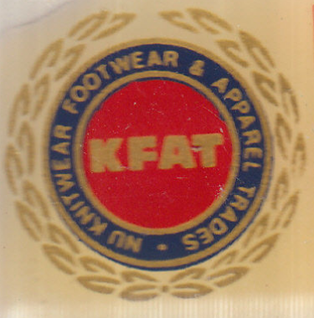Related Research Articles

The National Union of Knitwear, Footwear and Apparel Trades (KFAT) was a trade union in the United Kingdom.

The General Federation of Trade Unions (GFTU) is a national trade union centre in the United Kingdom. It has 35 affiliates with a membership of just over 214,000 and describes itself as the "federation for specialist unions".
James Bell was a British trade unionist and Labour Party politician who represented Ormskirk from 1918–22. He was described by a fellow union official as "one of the shrewdest negotiators the trade unions in the cotton industry had ever had."
The Northern Textile and Allied Workers' Union was a trade union representing cotton factory workers in northern Lancashire in England.
The Cardroom Amalgamation or Cardroom Workers' Amalgamation (CWA) was a British trade union which existed between 1886 and 1974. It represented workers in the cotton textile industry.

The Amalgamated Textile Workers' Union (ATWU) was a trade union in Great Britain.

The Amalgamated Weavers' Association, often known as the Weavers' Amalgamation, was a trade union in the United Kingdom. Initially, it operated in competition with the North East Lancashire Amalgamated Weavers' Association in part of its area, and it was therefore nicknamed the Second Amalgamation.
The United Textile Factory Workers' Association (UTFWA) was a trade union federation in Great Britain. It was active from 1889 until 1975.
The Amalgamated Association of Beamers, Twisters and Drawers (AABTD) was a British trade union which existed between 1866 and 2002. It represented skilled workers in the cotton industry who were responsible for preparing warp yarns prior to weaving.
The Amalgamated Textile Warehousemen's Association was a trade union representing workers in the textile industry in the United Kingdom, principally in Lancashire.
Fred Garfield Hague was a British trade unionist.
The North East Lancashire Amalgamated Weavers' Association was a trade union federation of local weavers' unions in part of Lancashire in England, in the 19th century.
The Burnley and District Weavers', Winders' and Beamers' Association was a trade union representing workers in the cotton industry in the Burnley area of Lancashire, in England. As cotton manufacturing dominated the town's economy, the trade union played an important role in the town, and several union officials became prominent national figures.
The Blackburn and District Weavers' Winders' and Warpers' Association was a trade union representing cotton industry workers in Blackburn, Lancashire, in England. One of the earliest weavers' unions to endure, it formed a model that many others copied, and was at the centre of early attempts to form a regional federation of cotton trade unions.
The Nelson Weavers' Association (NWA) was a trade union representing cotton weavers in the area of Nelson, Lancashire. As the main industry in the town, the union has been influential in its history, and some of its leaders became significant national figures.
Zephaniah Hutchinson was a British trade unionist and political activist. Known as the leading left-wing activist in the Lancashire cotton trade unions, he served for 28 years as leader of the Bacup Weavers' Association.
The Padiham and District Weavers', Winders' and Warpers' Association was a trade union representing cotton weavers in the Padiham area of Lancashire, in England.
The Rossendale Weavers', Winders' and Beamers' Association was a trade union representing cotton industry workers in the Rossendale area of Lancashire in England.
Jack Brown was a British trade union leader.
References
- 1 2 Fowler, Alan; Fowler, Lesley (1989). The History of the Nelson Weavers' Association. Nelson: Burnley, Nelson, Rossendale and District Textile Workers' Union. p. 118. Retrieved 10 April 2013.
- ↑ Marsh, Arthur; Ryan, Victoria; Smethurst, John B. (1994). Historical Directory of Trade Unions. Vol. 4. Farnham: Ashgate. pp. 112-113. ISBN 9780859679008.
- ↑ Honeyball, Simon (2012). Honeyball and Bowers' Textbook on Employment Law (12 ed.). Oxford: Oxford University Press. p. 345. ISBN 019963985X.
- ↑ Undy, Roger (2008). Trade Union Merger Strategies: Purpose, Process, and Performance. Oxford: Oxford University Press. p. 251. ISBN 978 0 19 954494 3 . Retrieved 10 April 2013.